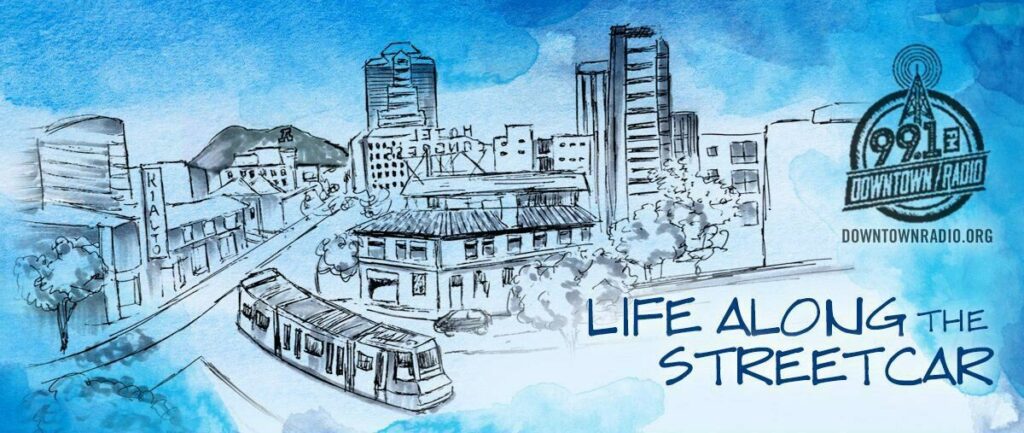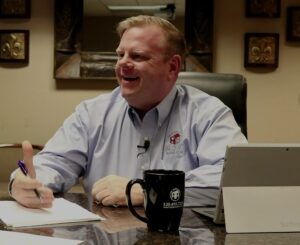Transcript
Tom Heath
Good morning. It’s a beautiful Sunday in the Old Pueblo and you’re listening to KTDT Tucson. Thank you for spending a part of your brunch hour with us on your downtown Tucson Community sponsored rock and roll radio station.
Tom Heath
This week, we’re going to speak with April Bourie of the Presidio San Augustine del Tucson Museum. We’re going to find out about how the past 245 years have been going, more importantly how the last couple of years have been going for the museum.
Tom Heath
Today is May 9th happy Mother’s Day to all, my name is Tom Heath and you were listening to Life along the streetcar. Each and every Sunday, our focus on social cultural and economic impacts in Tucson’s. Urban core, we shed light on hidden gems everyone should know about. From A Mountain to UArizona and all stops in between, you get the inside track right here on 98.1 FM. Streaming on Downtown Radio dot org. You can also head over to your App Store and download the Downtown Radio Tucson app and take us wherever you go.
Tom Heath
If you want to get us on the show, our email address is contact@Life Along the streetcar.org. Our past episodes are housed on Life along the streetcar .org and the podcast is available just about anywhere you can find a podcast or you can really just ask your smart speaker to play Life, along the streetcar podcast, and it’s going to pop up.
Tom Heath
We’re going to start Today’s Show with a little dining news. It’s Mother’s Day, it’s quite possible that you are headed to or at brunch with your family, celebrating the matriarch in your life. If you are downtown, it’s kind of bustling these days. Seems the post vaccine downtown era is starting to emerge and we have more folks out in about. And we’re going to start to see more of those restaurants expanding into open areas, mainly into the streets where the parking meters are.
Tom Heath
The City of Tucson has been working with a downtown Tucson partnership and Rio Nuevo to help some of the merchants that need a more seating in a safe and healthy environment, to get it. You may remember that just after covid hit, when there was concerns about the restaurants, the city allowed for some temporary easements on the sidewalks, and if you’re downtown, they rerouted the traffic around those little outdoor cafes on the sidewalks. And it’s gotten a little bit of a little convoluted because the pedestrians have to walk around the restaurant, which puts them into the street. There are PED rails up but certainly, it’s not an ideal situation.
Tom Heath
So those organizations, Downtown, City and Rio Nuevo, have been working together to find a more streamlined version of this easement process, so that the restaurants can move their cafes more permanently into the Street, and Rio Nuevo has offered a grants to some of these restaurants to help offset the cost. Since they spent so much on their temporary easement, now that they’re trying to do something a little bit more permanent, they need a little help with the funding. So be on the lookout for a different type of down town dining experience as we head into summer and fall.
Tom Heath
And speaking of a different type of experience, have you been to the presidium museum?
Tom Heath
The Presidio itself has been around since 1776 and the museum about 10 years or so ago. Really came into existence as a place where you could go and explore our history and culture. It’s on the the site of the original Presidio and there’s quite a bit of history in there and they do a living history days on 2nd Saturday’s, one was yesterday. We’ve had them on the show before, but so much has happened and changed with covid. We wanted to check back in so we caught up just just recently here with April Bourie of the Presidio Museum, to find out how things are going and what we can expect here for the rest of the year.
April Bourie
April Bourie, marketing and sales director for the Presidio of San Agustin del Tucson Museum.
Tom Heath
Now I know you haven’t been there for the entire 245 years as a person. You know, how long have you been with the museum?
April Bourie
I have been here since 2012.
Tom Heath
What got you connected?
April Bourie
Amy, the executive director and I actually went to the U of A together to get our master’s degrees and we kind of kept in touch after doing that. We both went our you know, separate ways and worked are different jobs and she called me one day and said “hey, what are you doing workwise?”
April Bourie
And I said well kind of working from home, you know, doing this and that and she said well would you want to come and do some marketing for the Presidio Museum? And I was like, I think that’s really exciting. So I took my kids down. In there, and they just happen to be a day after living history. And some of the soldiers were there, cleaning the cannon and so they said, hey kids, you want help us clean this cannon, they thought that was fantastic.
Tom Heath
April, we share something in common because this this show Life along the streetcar was really launched because I found out after living in Tucson for for many, many years, about the Second Saturday’s Living History of the museum and the cannon and I couldn’t believe at that time that I had never known that that existed, right? And I started this entire quest to find out things I didn’t know about Tucson and it’s it’s led to this show so that cannon…
April Bourie
That’s great. It has a lot of influence.
Tom Heath
For those that are not as familiar, tell us about where you’re located and the I know it’s 245 years. Give us the condensed version of the history of the, the Presidio.
April Bourie
Okay, well, the museum is located on the northeast corner of the original Presidio, which was located And we’re down to downtown Tucson is now. And we’re about, I think two or three acres, whereas the original Presidio is 11 acres. So we’re a much smaller, condensed version of what the Presidio would have been like, for those who don’t know, as you said, there’s also there was a presidio down in Tubac in the Seventeen hundreds, late Seventeen, hundreds and it was established there to protect the residents of that area from raiding Apaches and And that kind of thing. And of course, they were progressing, northward, the Spanish were, and of course, taking over lands and that kind of thing. So, they were protecting what they were basically taking.
April Bourie
But for them, the, the Presidio in Tubac wasn’t achieving the goals they were hoping that it would. So they decided to move a little bit further north into what is today’s Tucson and they chose the spot because it was right between the Catalina Mountains, the Rincon Mountains and the Santa Cruz mountains. And several of the Native American Trails crossed through there. And they thought, well, if we build a fort right here, we can control the whole area and everybody in it, which kind of worked not exactly as they had hoped. But this happened in 1775 for. Yeah, and 1775, they decided that they were going to close Tubac and move it to Tucson. And so, basically in 1776 is when people started arriving in the Tucson area and founding the Presidio.
April Bourie
It was a Spanish Fort until 1821 with Mexican Independence. So then it became a Mexican Fort and again it was to protect the settlers in the area. There was a friendly Tohono O’odham community and they thought that that was beneficial. It was close to the Santa Cruz river which gave them water and ways to plant crops and grow crops for themselves. So that was another beneficial reason for being there and It remained a Mexican Fort until 1854 with the Gadsden purchase when our area was purchased by the United States.
April Bourie
By the time, the US soldiers came out our way, approximately, two years later there really wasn’t much more need for the Fort and they didn’t really ever live in it or or do much with it and it started to crumble of course. And by late 1918, the last ending portion of the actual wall was torn down. However, we believe that, as more people moved into the Tucson area and the downtown Tucson area, a lot of the homes, we see like our gift shop, was an actual home. Probably used a lot of those bricks from the Presidio wall because it didn’t have to make them so it’s probably still alive and well in several of the buildings we see today, we can’t prove that but you know how these people were scavengers back then they used anything they could. So it’s most likely that several of those Bricks, Like I said are still holding up buildings in Tucson today.
Tom Heath
Well, the 1776 that lot of things happening in our country at that time for Tucson, that was an important time because this really became the founding of the City of Tucson.
April Bourie
Yes. I would say. Yeah. In modern history. Yes, you would look at it as European. Yeah, definitely settling in the area and and bringing their influence for sure.
Tom Heath
And I know we still celebrate the the founding father, quote-unquote, of Tucson who was part of that mission and had a very Spanish name. What was his name?
April Bourie
Oh yes, Hugo O’Connor but they called him. Hugo, he was actually Irish and had joined the Spanish Army because they would take him and they sent him out this way and said, find a new place, Tubac’s not working out. Find us a new place
Tom Heath
Whether the it came in disrepair, but theres been a renovation obviously. Amy and others have kind of brought this back on track. So tell us a little bit about that that renovation process.
April Bourie
Yeah. Well obviously, this downtown Tucson area grew up around in the walls were torn down and that kind of thing. And it came to pass that some people said, hey like you said, this is our history. This is something we need to remember and where the museum and is now used to be just a big parking lot and Gail Hartman, who’s Amy Hartman, our executive directors, mother, and several other people, Rick Collins and others have formed the Presidio trust and they wanted to create the museum, basically, so that people could come and see what a portion of the Presidio look like, see some living history activities, find out, you know, just kind of experience their history rather than read about it in a book or see it in pictures.
April Bourie
So, they were able to convince the city to renovate that parking lot. At the corner of Washington and Court.
Tom Heath
That’s a corner before Washington in Court. If you’re if you’re not as familiar with Tucson, this is going to be in the general area of like the Tucson Museum of Art, right. You’re a little bit on the northwest side of what we consider downtown right down the street from El Charro’s famous Mexican restaurant.
April Bourie
Yes. And across the street from Old Town Artisans so there’s a lot going on in our area. Like you said, you could spend probably a whole day there. Plenty of places to eat and and lots of other things to do, too. But anyway, so they they, like I said, got the city to agree to renovate this parking lot. They excavated it. They actually found several pit houses in the area, so we do have one of those on display in the middle of our Fort there so people can see that history as well.
Tom Heath
That that that’s not I mean that predates the…
April Bourie
oh yes. Yeah exactly. That was when just Native Americans were living in our area and they were building their pit houses farming along the Santa Cruz, and doing all that possibly back to 10,000 years ago. So, yeah, there’s quite a bit of history that you can see there. And so then of course, they recreated the walls and, and they put in the people who lived in the Presidio, basically their their rooms or homes were built right along the Presidio wall. That was one of their walls so they recreated home of both maybe a soldier with a family and then like a Barracks just for the single guys. So we have that in there too. That you can see. We also have what we call a Kemal which is like a grill where they would make the tortillas and things like that outside of course. So that wouldn’t smoke up all the inside and then an horno, more like an outdoor oven where we bake bread. Things like that too so that people can see how they cooked and you know how they live day-to-day, that kind of thing.
April Bourie
We have a storeroom with dried gourds and wheat that kind of thing, too kind of exhibit how they might have stored some of their things. We also have a blacksmith firing area where they can go and watch the blacksmiths at work and most of this happens during our Living History days. We do try to have some small demonstrations going on when more major events aren’t happening, but everything tends to go on more when there’s a Living History day. So anyway, the city first was the owner of the both, the land and the museum, they were ran it and it put it in there parks and rec department which was okay, but they tended to run, it more like a park and we want to do all the Presidio Trust wanted to run it more like a museum. So they finally convinced the city to give the management of the Presidio over to the Presidio trust. So the city still owns the land and basically the buildings but the Presidio trust manages the activities and economics.
Tom Heath
Well, we will speak about some of those activities. After the break. But I want to remind you that you are listening to Life along the streetcar on Downtown Radio 99.1 FM and available for streaming on Downtown Radio dot-org.
Tom Heath
Speaking of unique we’re going to get back to our interview with April for the presidium museum and find out what unique Adventures they have in store for us over the summer and the remaining parts of 2021.
April Bourie
We’ve done a lot more, we’re still fighting, you know, as you and I have discussed before the fact that we exist and that people don’t know where their and so I think we’re getting better at that with more advertising and spreading the word where, you know, what of math of course is always the best marketing. But doing things like this, talking to you on the radio and and we’re just trying to get the word out there. I think a lot of times and this probably happens for a lot of attractions, Tucson’s smaller ones anyway. People who come to visit, no more. About the smaller attractions than the people who live here, you know.
Tom Heath
We’re kind of teasing folks because we’ve both talked about living history days, the cannon and, and this whole event that takes place typically and second Saturdays, but they’ll, but the last one was just passed here in May, and we’re not gonna have another one until October, right?
April Bourie
Yes. Unlike those tough Spanish and Mexican soldiers that lived here, back in the day. Day. We do not force our volunteers to wear wool uniforms in June July and August, but they wouldn’t do it anyway.
Tom Heath
There are there are activities though.
April Bourie
There are. Yes that’s exactly. Yes. Summer summer has become you know quite an interesting thing for us. We are running live summer camps in person summer camps this year and its vast year was we did the same and it was very successful and of course, you know, we’re making the kids hand. Wear masks, you know, social distance that kind of thing but they can still learn about the history and experience it, make Adobe bricks and you know, all of that kind of thing, most of our areas are outside. But of course, when it gets more my in the afternoons, we bring the kids inside and do some calligraphy or whatever, but so, yeah, we’re actually hosting for summer camps. This year, 2011 is a repeat of the other. With a, it’s basically an overview of Tucson’s history called live Tucson’s history. Hurry, and that’s the first week of June, and then it repeats the last week of June. It’s not something you have to go to both it, you can choose either.
April Bourie
Then we’re also doing an archaeology summer camp, where the kids will do some will set up like an excavation area where they can excavate and find different artifacts. And that kind of thing and kind of map out. Oh, I found this here and I found that there. So really great for kids that are into that kind of thing. And finding out, you know what, what you find in the dirt, what it tells You about your history and then we’re doing a new one. This year that we haven’t done before. It’s a re-enactment camp actually. So the participants will come and dress in Stand. Period, uniform and learn plays and dramas about historic events that actually happened with historic people in them. And so they’ll get to reenact those those events and activities. So, all of those, I think it’s the first of the one, the first week, the lived through some history is the only One that sold out. So we still have spaces in others, so we’re doing that and because of that were closed during the week in June on the weekends were open so people can still come and see us.
April Bourie
We do clothes for the entire month of July and we’re actually going to be closed until August 20th which is to son’s birthday the day. They say that who go Oakland or said, okay, we’re putting the Presidio here. And so we’ll open onto son’s birthday with some music, and probably some food and Things been signed in ink yet, but we’re planning that activity right now and that kind of kicks off our whole fall season. And so then usually in September, we celebrate Mexican Independence Day, right around the actual date. And then October like you said, kicks off with living history on the second Saturday of the month.
Tom Heath
Well, we’ve got, we got things for adults to. I know, I have taken a couple of your guided tours. Yes. And those are those, you have like archaeologists and historians that lead those, correct?
April Bourie
Yes, exactly. We for those who aren’t familiar with the Turquoise Trail, it’s if you’ve been downtown so you can see the blue line on the sidewalk basically. It’s a trail that some of our board members created when the museum was first getting started and it highlights a lot of the historical aspects of Tucson. What happened after the foreclosed, and they opened up a camp, you know, on the west side or the east side of downtown and then finally eventually moved to Camp Lowell. So it talks about that The thing, as well as different areas of town, that may have been a red light districts or talking about the Pioneer Hotel and it’s big fire and pointing out where that happened and just lots of different aspects of Tucson’s history. It is led by some of our top historians that are on our board and our volunteers at our Museum and those have been very popular because, of course, they’re Outdoors. It’s easy to social distance. We do ask people to wear a mask and we just switched Those two evening towards this month, as it’s getting a little bit warmer. So those have been really popular and we limited to about 14 people and it’s about a two-and-a-half hour tour and 2.5 mile walking. So it’s not, you know, it’s certainly not a run or a race, it’s an easy pace. And so that’s, that’s one thing that we’ve been doing.
April Bourie
We’ve also been Zooming our lectures this year, and people really seem to like that having that option, of course, especially now and We’ve been talking about different famous people in history, and those Vanna’s areas about, you know, how the kids used to have to come out here because they had breathing diseases. And so they had to come out and and and go to stay in places like Tucson because it was dry and those kinds of things. Different historical people like John behan, and other railroad men who were famous at this time, and all of that. So, So it’s been really good in, those are only five dollars and you know you log in on zoom and you’re good to go.
April Bourie
We also as you mentioned for adults, have a docent class coming up that will be in the fall but there is a 10% discount if you sign up before May 16th. And that’s going to cover basically our docents are our lifeblood right? They’re the ones that do all of the living history and they provide the walking tours of the museum, which we do both on Thursdays and Fridays. For those Want to come for sure. And then of course, if we have a docent on site and people arrive and they want it, or they can do that as well, but we guarantee that we’ll have a do some on-site on Thursdays and Fridays. So docents do a lot for us. Like you said, provide tours, they reenact things in living history and other events we do. And so that class will start in September on September 11th and it goes to the next four weeks and covers the history and geography of the area. Area, basic Spanish, military history, and uniforms introduction to our interpretive kits that you can pull out. Say hey did you know that? You know this white stuff. This coaching Elan the prickly pear was once used as or actually still is used as created dies and used in food colorings and that kind of thing. And of course the talk about the Presidio neighborhood and all of those kinds of things and history of the Native Americans in the area and how their interaction Spanish kind of kicked off our culture. Like we’re turning around alarm our Multicultural history, so it’s a great broad overview. We of course, hope that people will come and be docents after, they take it, but there is also an option for those that are interested in just taking it for the knowledge of it and so people can find that information on our website.
Tom Heath
So we’ll certainly link to that. It’s a pretty simple. It’s TucsonPresidio.com we will link to that from our Facebook page and it one thing I did want to point out the The Turquoise Trail although I would highly recommend taking it a couple of times guided because the different docents, the people that take you along their they have different stories and they share, right different with different perspectives. So it’s it’s definitely worth taking a couple of times but if you don’t have time when it’s scheduled the trail is listed on a brochure you can get at the Museum.
April Bourie
Exactly. Yes. And we also have an app now to through Vermont and so you can do it on your phone. Yes. Exactly. So You just download the vo mon dap and then you go in there and search for Turquoise Trail and it’ll show up and it’s really neat because it knows where you are. So it’ll say ok now next you know go up here like on a Google map go up this way and turn right that’s the next stop and then you get a little blurb about that stop. But yes we also have for those who prefer a paper guide, we actually just reprinted and updated The Turquoise Trail Guide. There’s a lot of construction as you know, going on in downtown. So we’re trying to keep up with that a little bit but Yeah, you’d self-guided and that’s kind of nice because like you said, if you don’t have time to do the whole thing or, well I’ve already seen this part, I want to see that part, you can pick up and leave off wherever you like.
Tom Heath
And the self guided version is what I tell people one of downtown’s best dog, friendly activities.
April Bourie
It is your right. Exactly. And we’ve had people even on the guided tours day, so we take our dogs. I’m sure. As you know, long as they’re on a leash and they’re well-behaved no problems. So
Tom Heath
so much going on. We’re going to link over to to your website hope folks. Not can check it out and but one thing I want to hit on before we leave because if I understand correctly, you guys are so flush with cash, you’re not looking for any do anything.
April Bourie
It’s yes. Oh yes, that’s always you know, we’re just so lucky. No, that’s not true, especially with, you know, lowered visitation and that kind of thing. We will always take donations with love to and and you know, people don’t even really have to take the do some class to volunteer at the Museum. So So there’s information on our website to different volunteer opportunities and just click on that support button and it’ll tell you right there, how to donate online or give us a call, obviously, you know, will even take gifts from people’s wills and that kind of thing. Yes. Anyway, people would like to donate to us whether it’s monetary or time, we would love to have it for sure,
Tom Heath
245 years worth of History, appreciate you and all the efforts, being done to bring it back and just Continue to grow at year-over-year, absolute pleasure. We’ll check back in with you later in the fall to maybe catch up with one of those living history days. And just tell us what, what, what we need to know. So, just keep us in the loop. Otherwise, I hope you enjoy the rest of your mother’s day.
April Bourie
And thank you so much. I will.
Tom Heath
We will chat with you down the road. Thank you so much.
April Bourie
That sounds good. Thank you, Tom. I appreciate you having me.
Tom Heath
It was April Bourie, Marketing Director over at the Presidio Museum, been an operation here for Or ten or so years. I’ve been around for two hundred forty five years, great place to check out, highly, highly recommend the walking tours guided if you can but if you just want to get experience of downtown and little exercise, The Turquoise Trail just a self-paced or fantastic opportunity. My name is Tom. Heath you listening to lifelong the streetcar downtown radio, 98.1 FM and streaming a Downtown Radio dot org. And episode 150. Just flew by will say that tuned for words and work coming up with Ted ski as he interviews Riders and Others from the labor movement, just a few minutes. I’m going to leave you a little music today. In honor of all of our mothers including mine. This Alicia Keys Wonder Woman from 2007 off the. As I Am album, have a great weekend to next Sunday for more Life along the streetcar.




